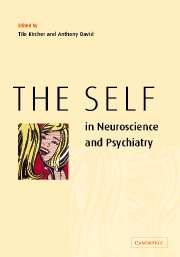Book contents
- Frontmatter
- Contents
- List of contributors
- Introduction: the self and neuroscience
- Part I Conceptual background
- Part II Cognitive and neurosciences
- 5 The multiplicity of consciousness and the emergence of the self
- 6 Asynchrony, implicational meaning and the experience of self in schizophrenia
- 7 Self-awareness, social intelligence and schizophrenia
- 8 The neural correlates of self-awareness and self-recognition
- 9 Autonoetic consciousness
- 10 The neural nature of the core SELF: implications for understanding schizophrenia
- Part III Disturbances of the self: the case of schizophrenia
- References
8 - The neural correlates of self-awareness and self-recognition
from Part II - Cognitive and neurosciences
Published online by Cambridge University Press: 18 December 2009
- Frontmatter
- Contents
- List of contributors
- Introduction: the self and neuroscience
- Part I Conceptual background
- Part II Cognitive and neurosciences
- 5 The multiplicity of consciousness and the emergence of the self
- 6 Asynchrony, implicational meaning and the experience of self in schizophrenia
- 7 Self-awareness, social intelligence and schizophrenia
- 8 The neural correlates of self-awareness and self-recognition
- 9 Autonoetic consciousness
- 10 The neural nature of the core SELF: implications for understanding schizophrenia
- Part III Disturbances of the self: the case of schizophrenia
- References
Summary
Abstract
Attempts to elucidate the brain correlates of self-awareness have existed for centuries. However, only now is a clear picture emerging. Based on case studies and modern neuroimaging, it appears that the right hemisphere and the prefrontal cortex, probably the right prefrontal cortex, is dominant for self-related processing. Studies implicating the right hemisphere/prefrontal cortex have focused on self-recognition, self-face recognition, autobiographical episodic memory and autonoetic consciousness. We present this evidence and argue that the right hemisphere/prefrontal cortex may be dominant for the self.
Introduction
This chapter attempts to integrate a number of experimental findings pertaining to the neural correlates of the self and self-related processing. In this context, we have previously suggested that the brain be viewed as an Alexander Calder mobile, delicate and balanced, with a certain interdependence amongst the elements (Keenan, 2001). Calder's mobiles are fragile, with wire or string holding together elements typically made of metal in such a manner that perfect balance is achieved across the entire creation. These elements, which on some levels can be described as discrete units, are never wholly independent, and their actions shift as the environment changes. Destruction of a single unit often affects the entire brain, even if the change across distant regions is subtle. Further, different environmental conditions, analogous to different cognitive demands, often involve numerous elements, and the same element is often involved under numerous tasks.
- Type
- Chapter
- Information
- The Self in Neuroscience and Psychiatry , pp. 166 - 179Publisher: Cambridge University PressPrint publication year: 2003
References
- 5
- Cited by



